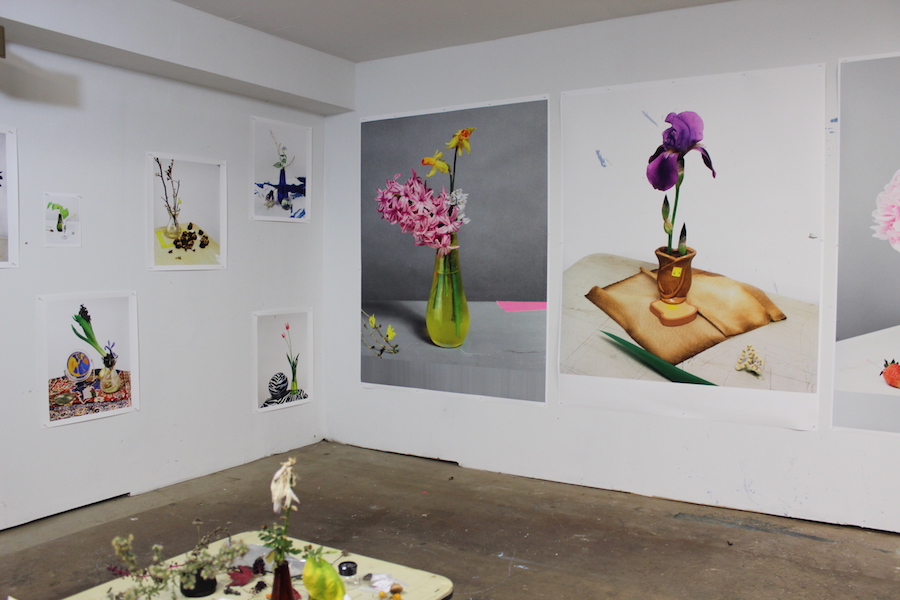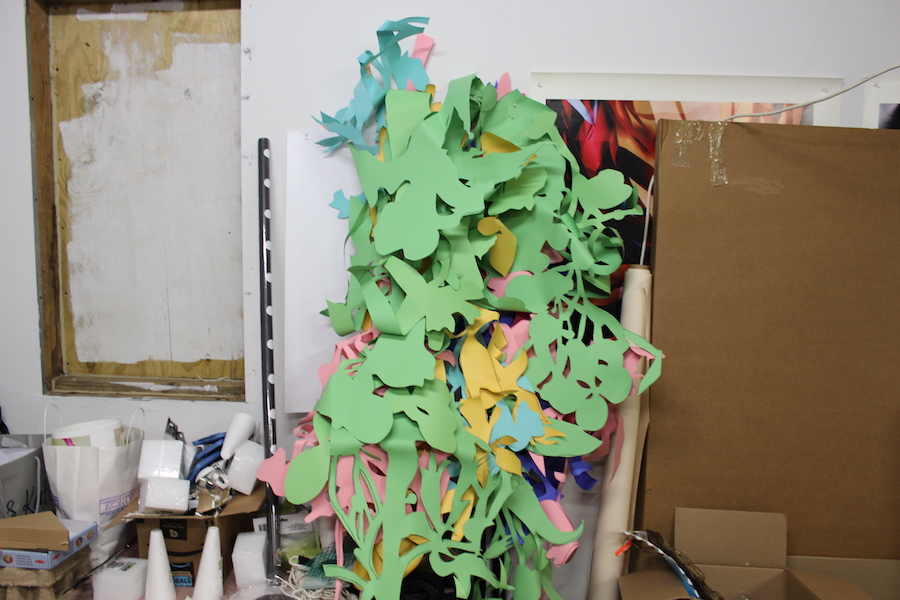Jessica Labatte’s studio is in the basement of her home in Winfield, Illinois. Despite not having windows, the underground workshop feels light and airy: Bright, large-scale photographs of Siberian Irises, poppies, and “Old-Fashioned” bleeding hearts are tacked to the far corner walls.
Labatte pulled the original flowers directly from her gardens — shaded spaces that curve around the wooded acre lot that she and her husband Eric May (director of Nobel Square gallery Roots & Culture) own. For her solo exhibition Shade Garden at Western Exhibitions, Labatte rigorously photographed each flower that blossomed during a growing season, pairing each with a thoughtful selection of studio detritus, her son’s toys, and other memory-laden objects born from her day-to-day. Accompanying this series, Almanac for Shade Gardeners, are selections from another body of work, Shadow Plants. Labatte’s multiple-exposure photographic images are highly influenced by abstraction, particularly the works of Swedish painter Hilma af Klint that are characterized by an otherworldly color palette.
I interviewed Labatte at her studio on the eve of her new exhibition, which opens today, November 2. Although early fall is not the ideal time to visit a shaded garden, a walk through the dormant flower beds suggested life forms that had once crept up the couple’s backyard arbor, penetrated the planted beds near their front steps, and blossomed just below their bedroom window.

Creating a bouquet has always been one of my favorite ways to transform and brighten a space; flower arrangements are also just very pretty. Was their inherent beauty one of the reasons you were interested in falling more deeply into a flower-oriented practice?
Last summer, I started reading a lot of texts about feminism. I found this bell hooks article that speaks about beauty in the everyday. She explained that as a society, we have a lack of beauty in our lives, which leads to this deep spiritual lack in our psyche. I found that the more present I was, the less I had that feeling. This work really came out of wanting to appreciate beauty in my everyday, wanting the work to speak for a radical beauty, and thinking about the everyday as a radical gesture.
Did you intend to photograph every flower that blossomed in your yard, or did that gesture evolve naturally as you worked with your garden?
Last year, I made a couple of still-life bouquets, maybe five, that were really lovely. I was thinking about time a lot because when you are raising a kid, it feels so different. You are held to a strict schedule and seem to be doing something different every two hours. It really opened up a new way of thinking about time. I started thinking about these works like a calendar. Sometimes I would get lots of blossoms that occurred at the same time because of the weather, and then other times I would be forced to anticipate when the next one would bloom. I was held accountable to the flowers, while at the same time celebrating the variety of life we were able to care for.
When Eric and I first moved out here, there were already some things in the gardens, but we got really interested in planning how we could expand upon what was already there. Because we are in a wooded lot we don’t have a lot of the really dramatic, late summer blooms like you might find in a full-sun garden. There was this rigor of the flowers unfolding on their own time schedule and me having to work with what they presented. As they would bloom, I would have short windows to document them before they would start to wilt, so it forced me to have consistent time in the studio.
I like the idea that you were held accountable by the flowers. Their blooming was out of your control, yet it still drove you to create each photograph. How else have you had to adapt your image-making now that your studio has moved outside of the city?
I had a really hard transition to this particular suburban landscape. I had always been someone that had used found objects to make work — bits of trash along the street, or rocks that lined the seashore. It took me a while to realize how much there was around me in my new environment. After Avery was born I had to be super present with him. The more attentive I became to everything around me, the less anxious I was about not being in the studio. I now collect things all day when I am with Avery, and he allows me to pay attention to objects that I might have never noticed before. I started thinking of every little detail we experienced together as being very meaningful and important.
.JPG)
How much consideration did you give to the design of the bouquets? Do you consider the act of arranging as part of the art form, or relate it in any way to ikebana?
I’ve learned about the philosophy of ikebana from a vintage book that I own; however, I do not consider myself an expert. There are diagrams in the book that explain how each flower represents a different element of the landscape — whether it is a mountain, butterfly, or the sun. This prompted me to think about the still lifes as representations of the larger cosmos of my life. The flowers included in each image are only one element, but there is also the detritus of the house or the studio which become important elements in the work as well. Sometimes I will find a quick resonance between the flowers and objects that I have found around the house that day. Other elements are objects that have been a part of our lives for a long time, such as a quilt I made Eric for his birthday several years ago, or an ornate tapestry that was draped over my parents’ dresser while I was growing up.
The catalog for Shade Garden includes an interview between you and Eric in your garden. How does this exchange speak to his relationship to your studio practice?
After Avery goes to sleep, we will get a cocktail and walk around the garden. This has been our practice since before he was born. During our walks we look at the flowers, observing what is ready to bloom and discussing which areas we would like to plant or develop. It has become this ritual for us, and it also inspired the work in that way. He is my partner in life and this shift out here to this more domestic lifestyle has been about the two of us. Although the work is definitely about me and about feminism, he is a part of that too.

You take each of your still life images with a large format camera. Do you touch up the results in Photoshop?
No — I leave in all of the dust and scratches that collect on the film. It allows you to be seduced by the image while also finding moments that jilt you back into knowing that this is in fact a picture, a print — it’s not the real thing. Leaving the dust in is a move that is very anti-traditional, but for me, it speaks to a political worldview of not hiding the imperfections, not removing the things that we don’t like. It’s keeping everything there, all of the messiness, and letting that be a part of the world because it is much more interesting that way.
How does your other series for the exhibition, Shadow Plants, showcase a different side of the plants you are working with?
The works are made from the dried bouquets I have created for the still life images. Once the bouquets have passed their peak, I place them on an overhead projector. I project them onto the wall and trace their forms onto colored paper. I then take multiple exposures of the paper installed on the wall with the dried flowers still projected. I intend to capture this flickering, fleeting light that you get when you are in the garden and the leaves are changing, moving, and dappling the light. I know they look much different from the still life bouquets, but they are totally connected in my mind.
Shade Garden runs through December 22.


